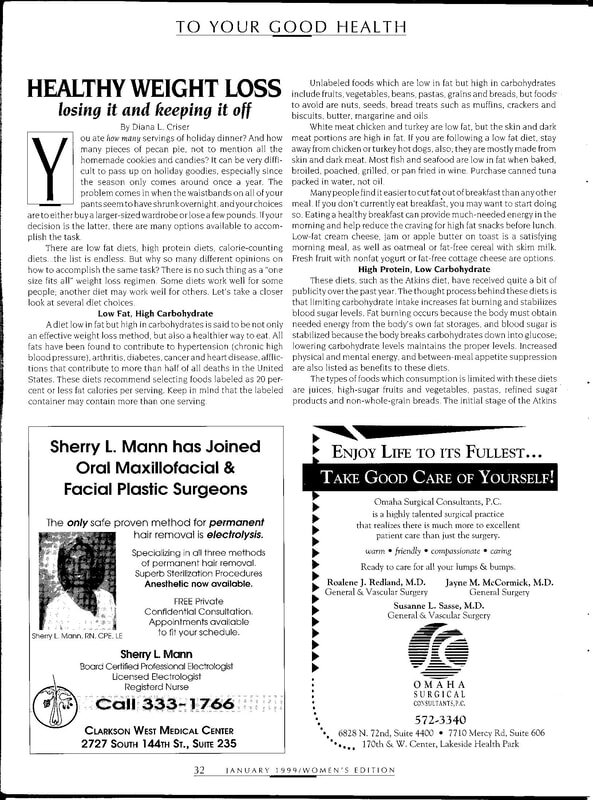To Your Good Health - January 1999
HEALTHY WEIGHT LOSS: LOSING IT AND KEEPING IT OFF
By Diana L. Criser

ou ate how many servings of holiday dinner? And how many pieces of pecan pie, not to mention all of the homemade cookies and candies? It can be very difficult to pass up on holiday goodies, especially since the season only comes around once a year. The problem comes in when the waistbands on all of your pants seem to have shrunk overnight, and your choices are to either buy a larger-sized wardrobe or lose a few pounds. If your decision is the latter, there are many options available to accomplish the task.
There are low fat diets, high protein diets, calorie-counting diets...the list is endless. But why so many different opinions on how to accomplish the same task? There is no such thing as a "one size fits all" weight loss regimen. Some diets work well for some people; another diet may work well for others. Let's take a closer look at several diet choices.
Low Fat, High Carbohydrate
A diet low in fat but high in carbohydrates is said to be not only an effective weight loss method, but also a healthier way to eat. All fats have been found to contribute to hyper tension (chronic high blood pressure), arthritis, diabetes, cancer and heart disease - afflictions that contribute to more than half of all deaths in the Unites States. These diets recommend selecting foods labeled as 20 percent or less fat calories per serving. Keep in mind that the labeled container may contain more than one serving.
Unlabeled foods which are low in fat but high in carbohydrates include fruits, vegetables, beans, pastas, grains and breads, but foods to avoid are nuts and seeds; bread treats such as muffins, crackers, and biscuits; and butter, margarine, and oils.
White meat chicken and turkey are low fat, but the skin and dark meat portions are high in fat. If you are following a low fat diet, stay away from chicken or turkey hot dogs; they are mostly made from skin and dark meat. Most fish and seafood are low in fat when baked, broiled, poached, grilled, or pan fried in wine. Purchase canned tuna packed in water, not oil.
Many people find it easier to cut fat out of their breakfast than any other meal. If you don't currently eat breakfast, you may want to start doing so. Eating a healthy breakfast can provide much needed energy in the morning and help reduce the craving for high fat snacks before lunch. Low fat cream cheese, jam or apple butter on toast is a satisfying morning meal, as well as oatmeal or fat free cereal with skim milk. Fresh fruit with nonfat yogurt or fat free cottage cheese are also options.
High Protein, Low Carbohydrate
These diets, such as the Atkins diet, have received quite a bit of publicity over the past year. The thought process behind these diets is that limiting carbohydrate intake increases fat burning and stabilizes blood sugar levels. Fat burning occurs because the body must obtain needed energy from the body's own fat storage, and blood sugar is stabilized because the body breaks carbohydrates down into glucose; lowering carbohydrate levels maintains the proper levels. Increased physical and mental energy, and between-meal appetite suppression are also listed as benefits to these diets.
The types of foods which consumption is limited with these diets are juices, high sugar fruits and vegetables, pastas, refined sugar products and non-whole-grain breads. The initial stage of the Atkins diet suggests the following menu:
Breakfast: eggs and bacon
Lunch: bacon cheeseburger (no bun) and small tossed salad
Dinner: shrimp cocktail with mustard and mayonnaise, clear broth, steak, tossed salad, and low fat gelatin with whipped cream
These diets have also been referred to as "low calorie diets in disguise", because the menu listed above contained approximately 1750 calories. A moderately active 5'4", 125-pound female requires about 2000 calories per day to maintain her existing weight. When lower calories are consumed, the body starts to burn its own fat, and the body goes into survival mode due to low carbohydrate intake.
Calorie Counting
To lose 25 pounds or less, multiply your current weight (in pounds) by 10. This will give you the number of calories you can eat and still lose approximately one pound a week. The following menu assumes you are consuming around 1,400 calories a day:
Meat: 2 servings (trimmed lean meat, poultry, fish or eggs)
Milk: 2 servings (skim milk, nonfat yogurt, low fat cheese)
Oil: 2 servings (margarine, mayonnaise, salad dressing or vegetable oil)
Fruit: 2 servings, preferably fresh
Vegetable: 3 servings (raw, cooked, or juice)
Bread: 7 servings, preferably whole gain (pasta, potatoes)
In addition to the above-listed servings, unlimited amounts of the following items are allowed, due to their low calorie content: lemon or lime juice, sparkling water, dill pickles, coffee or tea, horseradish, vinegar, fat free broth, Worcestershire or soy sauce, and mustard.
Unfortunately, as many as 95 percent of people who lose weight regain it within five years. An important part of losing weight and keeping it off involves creating a healthier lifestyle.
Whatever type of diet you choose, include regular aerobic exercise for more than 20 minutes, three or four times a day. This combination is healthier, leads to faster weight loss, and increases your chances of keeping the weight off. Muscles weigh more than the same area of fat, but they also burn calories by simply existing.
Also keep in mind that losing a large amount of weight over a short period of time is hard on your body, and that changing your eating habits, such as eating slower and taking smaller bites, will be more beneficial in the long run. Good luck in losing those extra holiday pounds, and keeping them off!
There are low fat diets, high protein diets, calorie-counting diets...the list is endless. But why so many different opinions on how to accomplish the same task? There is no such thing as a "one size fits all" weight loss regimen. Some diets work well for some people; another diet may work well for others. Let's take a closer look at several diet choices.
Low Fat, High Carbohydrate
A diet low in fat but high in carbohydrates is said to be not only an effective weight loss method, but also a healthier way to eat. All fats have been found to contribute to hyper tension (chronic high blood pressure), arthritis, diabetes, cancer and heart disease - afflictions that contribute to more than half of all deaths in the Unites States. These diets recommend selecting foods labeled as 20 percent or less fat calories per serving. Keep in mind that the labeled container may contain more than one serving.
Unlabeled foods which are low in fat but high in carbohydrates include fruits, vegetables, beans, pastas, grains and breads, but foods to avoid are nuts and seeds; bread treats such as muffins, crackers, and biscuits; and butter, margarine, and oils.
White meat chicken and turkey are low fat, but the skin and dark meat portions are high in fat. If you are following a low fat diet, stay away from chicken or turkey hot dogs; they are mostly made from skin and dark meat. Most fish and seafood are low in fat when baked, broiled, poached, grilled, or pan fried in wine. Purchase canned tuna packed in water, not oil.
Many people find it easier to cut fat out of their breakfast than any other meal. If you don't currently eat breakfast, you may want to start doing so. Eating a healthy breakfast can provide much needed energy in the morning and help reduce the craving for high fat snacks before lunch. Low fat cream cheese, jam or apple butter on toast is a satisfying morning meal, as well as oatmeal or fat free cereal with skim milk. Fresh fruit with nonfat yogurt or fat free cottage cheese are also options.
High Protein, Low Carbohydrate
These diets, such as the Atkins diet, have received quite a bit of publicity over the past year. The thought process behind these diets is that limiting carbohydrate intake increases fat burning and stabilizes blood sugar levels. Fat burning occurs because the body must obtain needed energy from the body's own fat storage, and blood sugar is stabilized because the body breaks carbohydrates down into glucose; lowering carbohydrate levels maintains the proper levels. Increased physical and mental energy, and between-meal appetite suppression are also listed as benefits to these diets.
The types of foods which consumption is limited with these diets are juices, high sugar fruits and vegetables, pastas, refined sugar products and non-whole-grain breads. The initial stage of the Atkins diet suggests the following menu:
Breakfast: eggs and bacon
Lunch: bacon cheeseburger (no bun) and small tossed salad
Dinner: shrimp cocktail with mustard and mayonnaise, clear broth, steak, tossed salad, and low fat gelatin with whipped cream
These diets have also been referred to as "low calorie diets in disguise", because the menu listed above contained approximately 1750 calories. A moderately active 5'4", 125-pound female requires about 2000 calories per day to maintain her existing weight. When lower calories are consumed, the body starts to burn its own fat, and the body goes into survival mode due to low carbohydrate intake.
Calorie Counting
To lose 25 pounds or less, multiply your current weight (in pounds) by 10. This will give you the number of calories you can eat and still lose approximately one pound a week. The following menu assumes you are consuming around 1,400 calories a day:
Meat: 2 servings (trimmed lean meat, poultry, fish or eggs)
Milk: 2 servings (skim milk, nonfat yogurt, low fat cheese)
Oil: 2 servings (margarine, mayonnaise, salad dressing or vegetable oil)
Fruit: 2 servings, preferably fresh
Vegetable: 3 servings (raw, cooked, or juice)
Bread: 7 servings, preferably whole gain (pasta, potatoes)
In addition to the above-listed servings, unlimited amounts of the following items are allowed, due to their low calorie content: lemon or lime juice, sparkling water, dill pickles, coffee or tea, horseradish, vinegar, fat free broth, Worcestershire or soy sauce, and mustard.
Unfortunately, as many as 95 percent of people who lose weight regain it within five years. An important part of losing weight and keeping it off involves creating a healthier lifestyle.
Whatever type of diet you choose, include regular aerobic exercise for more than 20 minutes, three or four times a day. This combination is healthier, leads to faster weight loss, and increases your chances of keeping the weight off. Muscles weigh more than the same area of fat, but they also burn calories by simply existing.
Also keep in mind that losing a large amount of weight over a short period of time is hard on your body, and that changing your eating habits, such as eating slower and taking smaller bites, will be more beneficial in the long run. Good luck in losing those extra holiday pounds, and keeping them off!
DROP ME A LINE
Like what you see? Let's get in touch!
Diana Criser, CUA, CXA
User Experience Practitioner
Omaha, Nebraska
User Experience Practitioner
Omaha, Nebraska
402.598.4969


